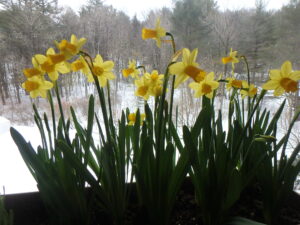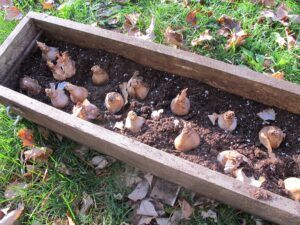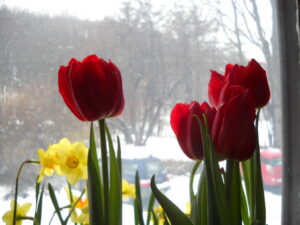Most bulbs are described on their packages as early, mid-season or late. Go to your local garden center and look for bulbs that are labeled as early bloomers – they are the best for forcing. Buy daffodils, some tulips and maybe some small bulbs like crocus or grape hyacinths. You can plant these bulbs in large pots or even in your window box if you bring it in.
You will also need some potting soil and compost. I make a mix that is half compost, half potting soil for forcing bulbs. I don’t use garden soil because it can be heavy and often stays wet. Bulbs can rot if they are left in wet soil for too long. I often reuse the potting mix that I used for growing annual plants outdoors in summer. I just pull up the summer’s plants, fluff up the soil, add some compost as needed, and make sure it is damp to start. If it is dry, I water it before I plant my bulbs.
Each year I plant about 25 daffodils in a window box that is about 30 inches long, 6 inches wide and deep. I prefer to get all of one kind so that they all bloom at once.

Tete a tete daffodils forced to bloom on a windowsill
I fill the window box a little more than half full with my mixture of compost and potting soil and place the bulbs, pointy end up, in the soil. Once I have them all in place I push them down more and fill up the box with more potting soil-compost mixture.
Be sure to label each pot with the date planted, and what is planted. Later, that will tell you when you can bring it into the warmth. Daffodils take about 12 weeks of dormancy before they should be brought into the warmth of the house, and tulips do better with 4 full months. Little things like crocus can be forced in 8 to 10 weeks.
Often bulbs will send roots out through the holes in the bottom of the pot or send up green shoots telling you they are ready. But don’t rush the process. Tulips brought up early will have nice green leaves, but no flowers.
Ideally temperatures for bulbs used for forcing will be between 32 and 50 degrees, though colder temperatures should not be a problem (my basement often goes below freezing for a few days). Left in a warm location, the bulbs will grow green tops – but not blossoms. Bulbs left in a cold basement or garage will do just fine. Inside the bulkhead to your cellar might be the right temperature, too.
You need to be aware that rodents like eating bulbs (indoors or out) – especially tulips. My basement has, most years, harbored mice and sometimes even a resident red squirrel. Unlike tulips, daffodils are not of interest to rodents as they are mildly poisonous. I keep my pots of tulips covered with hardware cloth (a fine-mesh metal screening available at hardware stores). But wear gloves if you cut hardware cloth to size – the edges are as sharp as razor wire.
You can double your production of blooms by planting two layers of bulbs in a container. Plant big bulbs deep in the pots, add soil, and then plant a layer of crocus or other small bulbs above them.

Daffodils being planted in a window box for forcing
It is important to check on the bulbs you are forcing at least once a month, particularly if you have put wire rodent-proofing over the containers. I’ve had shoots try to grow through the hardware cloth and get damaged. If the bulbs are sending up shoots, remove the wire mesh. I also don’t want the soil mix to get bone dry, so I check it and water a little if it’s dry. The bulbs will grow roots when first planted, and then go dormant if kept in a dark, cold location.
When it is time to bring up your potted bulbs into a warm place, let them wake up gently. My mudroom is good for starting them: there is some sunshine but it is cool. Then, once the shoots are up and green, I place the containers on my sunniest window sills – either east- or west-facing.
Most bulbs that have been forced are not likely to flower the following year, even if you keep the foliage alive until spring and plant them outside. I’ve done it, and some daffodils will build up the energy to blossom after a while, but tulips are not so cooperative.
I was a Peace Corps volunteer in Cameroon, West Africa many years ago. There I could have flowers blooming every day of the year. It spoiled me, perhaps, because I still want flowers every day. Forcing bulbs is one way to have lots of blossoms when there is snow on the ground. So don’t wait until mid-December to start your bulbs, get on this project now.
Henry is the author of 4 gardening books, and is a long time UNH Master Gardener. Reach him at PO Box 364, Cornish Flat, NH or
henry.homeyer@comcast.net.





